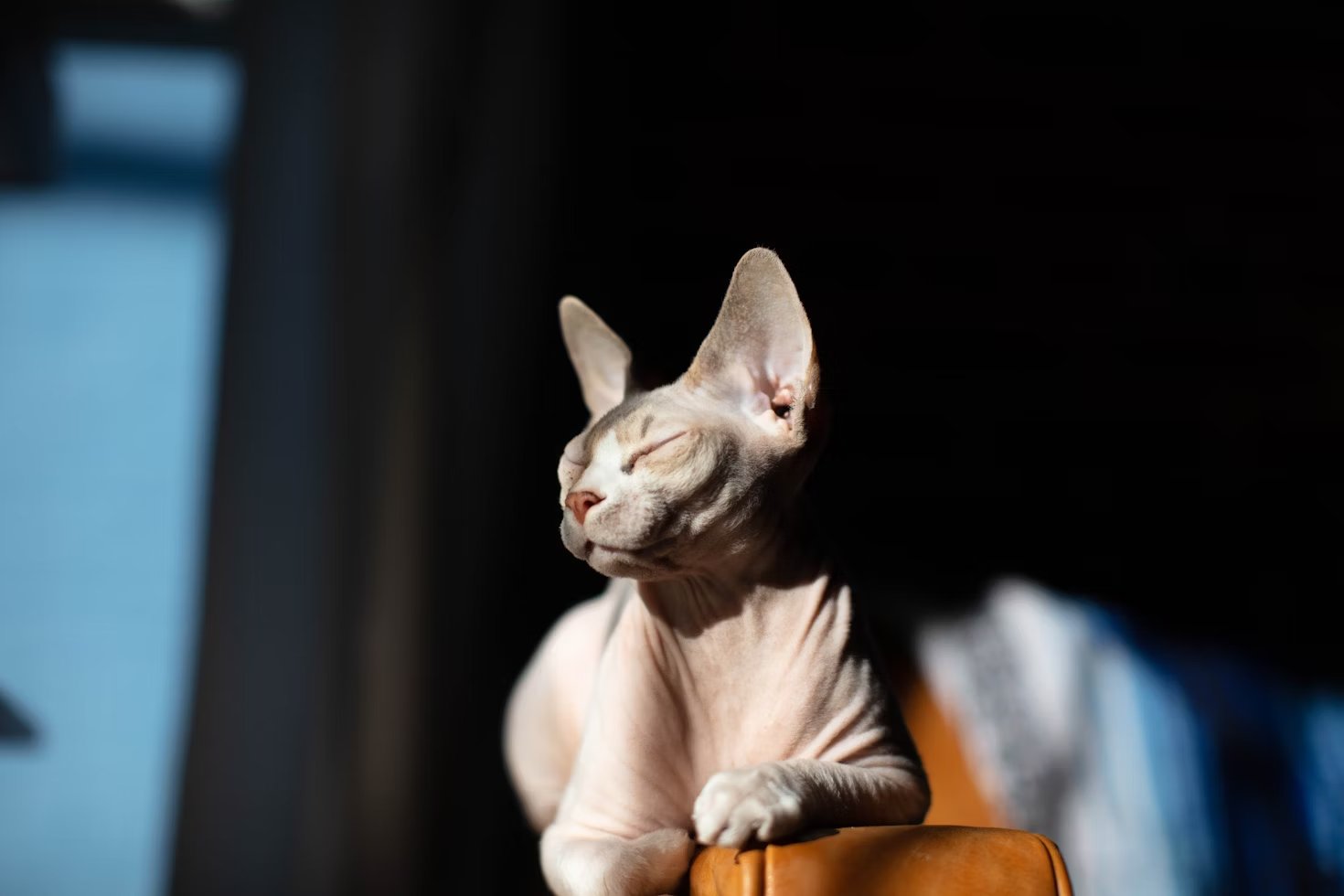
Sphynxes and other hairless breeds of cats are known to get chilly easily but are they also likely to overheat in summer?
Sphynxes and other hairless cats overheat and are at risk for sunburn. These cats need sunscreen or clothes to protect them from direct sunlight outside. Provide plenty of water to drink and a cooling mat or a fan for your cat on hot days.
What Range of Temperatures Do Sphynxes And Other Hairless Cats Like?
The ideal temperature for hairless cats, including Sphynx cats, is around 20°C (68°F).
Animals adapt, to a certain extent, to their climate. So, a Sphynx living in a hot environment will tolerate higher temperatures a little better than a cat that lives in a cold place.
Cat characteristics, such as age and health, also affect how well the animal can tolerate higher-than-optimal temperatures.
How Hot Is Too Hot For A Hairless Cat?
Your Sphynx is generally fine indoors in temperatures as high as 26-30°C (80-86°F), as long as the space is well-ventilated. If your hairless cat is outside on a hot day, direct sunlight can be dangerous to the animal, even with sunscreen or clothes on.
THERMOREGULATION IN HAIRLESS CATS
– High Metabolism
Sphynxes and other bald cats have a fast metabolism, meaning that they digest their food quickly and the physiological processes in their bodies are fast.
As a result, they have higher resting heart rates, sweat more, and sometimes have issues with their skin. They have a slightly higher need for nutrients and their normal body temperature is a little higher than most cats’.
Due to the higher metabolism, a Sphynx cat can become dehydrated quicker than most cats, which further predisposes the animal to heatstroke.
– Lack Of Insulation
Being bald, Sphynx cats get cold easily, of course, but fur insulates and protects cats from the heat too, as well as UV light, moisture, insects, and injury of any kind. Fur is a barrier and the Sphynx does not have its advantages.
Sphynx cats are prone to sunburns and hyperthermia when outdoors. If your pet spends time outside in hot weather, consider putting on a light protective vest and applying non-toxic sunscreen on the areas of skin that are not covered.
INDIVIDUAL RISK FACTORS FOR HYPERTHERMIA IN CATS
– Acclimation
Acclimation, or adapting to the typical environment, is an important factor but it is not always reliable and is very individual.
Cats adapt to their environments. Your cat can get used to a slightly cooler or warmer than optimal temperature over time. However, it is important to pay attention to your pet’s behaviors and needs and any additional risk factors that could impact the cat’s ability to acclimate.
– Age And Health Status
A healthy adult cat is likely to have a better tolerance to extreme conditions than a kitten or an elderly or unhealthy animal.
An animal with health problems is at risk of becoming too hot. Heart problems or respiratory issues, as well as thyroid disorders, predispose cats to overheating.
How To Tell If Your Cat Is Too Hot
These are the signs of heatstroke in a cat:
- panting
- vomiting
- lethargy
- restlessness
- other behavioral changes and signs, including confusion
- altered gate, clumsiness
- red or purple tongue and mouth
Since a bald cat has no fur, it is easier to detect a change in body temperature. Your pet would feel hot. When the cat’s body temperature reaches 40.5°C (105°F), the cat has developed heatstroke.
Late signs of heatstroke include the following:
- severe changes in the walking or movement pattern
- inability to eat and drink
- extreme lethargy
What To Do If Your Hairless Cat Has Heatstroke
If an animal has mild heatstroke, moving the cat away from the heat, providing cool water to drink, and applying cool wet towels are usually sufficient measures. Severe heatstroke, however, is extremely dangerous.
Here is what you should do if your cat overheats:
- Take the animal away from the hot area as soon as possible
- Put cool wet towels over the cat’s body
- Avoid putting ice or giving ice-cold water to the cat to prevent shock
- If the cat can drink water, offer cool water but do not force it if the animal cannot drink or refuses to drink.
If your cat cannot walk or drink water, or becomes unresponsive, take him to a veterinarian clinic as soon as possible, in order to start intravenous hydration and other interventions.
How To Prevent Overheating In Hairless Cats
To keep your bald cat cooler indoors:
- Make sure your home is well-ventilated. Proper air circulation is important in maintaining a lower air temperature.
- Provide plenty of cool water. Keep several bowls in different rooms as needed – some animals forget to drink enough water, and water bowls all over the place serve as reminders.
- Consider getting a cooling mat for your cat. Most likely, the cat will only use it if it is extremely hot but it can be helpful. This cooling pad is non-toxic and does not require electricity or water.
If your Sphynx goes outside for periods, keeping the cat cool and safe in hot weather is hard but taking general precautions is helpful:
- Protect the cat’s paws by applying paw balm, unless the cat only walks on grass and ground. Be sure to get a non-toxic product since your pet will try to lick it off the paws.
- Bald cats could get sunburned and need sunscreen or a light cotton vest to protect the most vulnerable areas.
- Let the cat out in the morning or late afternoon and try to keep him/her indoors during the hot part of the day.
- Make sure the animal stays hydrated. If your cat spends time in your yard, keep a bowl of water outside, too
Should Hairless Cats Go Outside At All?
Sphynxes and other hairless cats can spend some time outdoors but it is best to let them venture out when it is neither too hot nor too cold.
Given, their lack of protective fur, Sphynx cats need more precautions and supervision to stay safe and cool outside.
Any cat that does not go outside often is typically not well adjusted to surviving outside.
Recent Posts
Sphynx Donskoy Sphynx and Donskoy breeds look similar but they are not related. Different mutations cause these cats' hairlessness. Donskoys are heavier and have more variation in how much...
Whiskers are a sophisticated sensory mechanism. How do bald felines maintain their balance without whiskers? Sphynxes and other hairless cats can balance without whiskers because whiskers do not...

